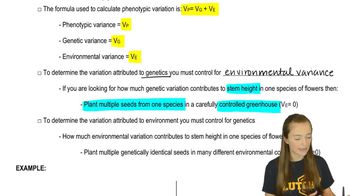20. Quantitative Genetics
Analyzing Trait Variance
Practice this topic
- Multiple Choice
Which of the following represent trait variation caused from genetic variation?
- Multiple Choice
If you wanted to identify what proportion of trait variation is due to the environment, you would do what?
- Multiple Choice
If you wanted to identify what proportion of trait variation is due to genetics, you would do what?
- Open Question
In this chapter, we focused on a mode of inheritance referred to as quantitative genetics, as well as many of the statistical parameters utilized to study quantitative traits. Along the way, we found opportunities to consider the methods and reasoning by which geneticists acquired much of their understanding of quantitative genetics. From the explanations given in the chapter, what answers would you propose to the following fundamental questions:
How do we assess environmental factors to determine if they impact the phenotype of a quantitatively inherited trait? - Open Question
A dark-red strain and a white strain of wheat are crossed and produce an intermediate, medium-red F₁. When the F₁ plants are interbred, an F₂ generation is produced in a ratio of 1 dark-red: 4 medium-dark-red: 6 medium-red: 4 light-red: 1 white. Further crosses reveal that the dark-red and white F₂ plants are true breeding
Predict the outcome of the and generations in a cross between a true-breeding medium-red plant and a white plant. - Open Question
A dark-red strain and a white strain of wheat are crossed and produce an intermediate, medium-red F₁. When the F₁ plants are interbred, an F₂ generation is produced in a ratio of 1 dark-red: 4 medium-dark-red: 6 medium-red: 4 light-red: 1 white. Further crosses reveal that the dark-red and white F₂ plants are true breeding
Assign symbols to these alleles, and list possible genotypes that give rise to the medium-red and light-red phenotypes. - Open Question
Height in humans depends on the additive action of genes. Assume that this trait is controlled by the four loci R, S, T, and U and that environmental effects are negligible. Instead of additive versus nonadditive alleles, assume that additive and partially additive alleles exist. Additive alleles contribute two units, and partially additive alleles contribute one unit to height.
If an individual with the minimum height specified by these genes marries an individual of intermediate or moderate height, will any of their children be taller than the tall parent? Why or why not?

